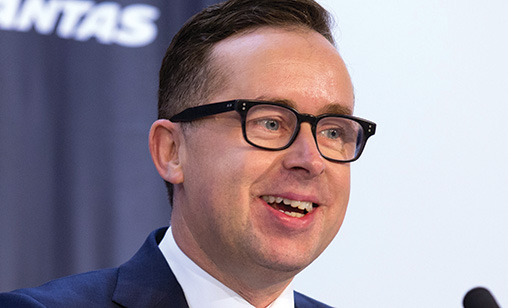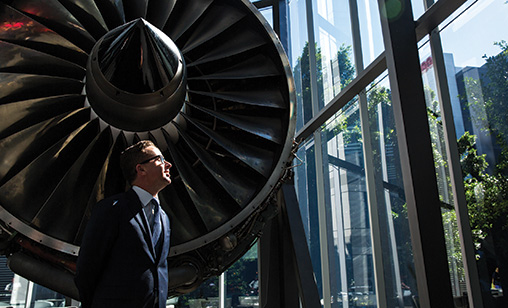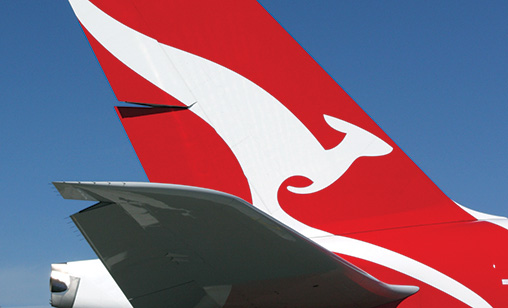Cover Story
Loaded
Qantas Group CEO, Alan Joyce answers his critics with record profits and transformed international operations.
July 1st 2016
If Qantas Airways group CEO, Alan Joyce, has any concerns about Chinese investors’ recent dramatic moves into the boardroom of arch rival, Virgin Australia, he is not showing it. Read More » As events played out at Virgin Australia’s Brisbane headquarters, following the announcement that Hainan Airlines parent, the HNA Group, was taking a major shareholding in the airline, Joyce was in a Dublin hotel meeting room with China Eastern Airlines chairman, Liu Shaoyong. Under discussion was the expansion of the partnership between Qantas and the Shanghai-based member of China’s “Big Three” airlines.
Joyce demonstrated the same equanimity a few days later when Air New Zealand announced it was selling most of its own holding in Virgin Australia to Chinese engineering and construction conglomerate, Nanshan Group.
 |
| 'There are lots of opportunities, not just with the B787s, not only in Qantas but in the Jetstar operations. It’s a lot better than we were a few years ago when we were struggling to justify acquisitions of aircraft for parts of our business that were not making returns. We’re in such a great position now that return on investor capital across all of our businesses covers its back and it is allowing us to go after growth for the first time in a long, long while' |
| Alan Joyce Qantas Airways group CEO |
In the Irish capital to attend the International Air Transport Association (IATA) annual general meeting, Joyce brushed off suggestions that a potentially resurgent Virgin Australia, now approved to fly to China for the first time, and allied with Hainan, China’s fourth largest airline, might alter the balance of airline power Down Under.
“We think our position in Asia, including China, is very, very strong given the fact we have a massive network from Australia into a lot of destinations in Asia and that the partnerships we have in the region are just phenomenal,” he told Orient Aviation.
“We have a great partnership with China Eastern. We have a code share with China Southern [Airlines]. We have a network in China that is pretty well established. We have just moved into Eastern’s terminal at Shanghai’s Pudong airport.
“It’s a big China market with huge growth. It’s a market that has more than 120 million tourists a year of which Australia, as we all know, gets 1%. It’s a market I think will quadruple in the next few years.”
It is not only mainline Qantas that is broadening its presence in China. Its low-cost subsidiary, Jetstar, and its stable of Asian offshoots have an expanding Mainland network.
Joyce pointed out that estimates are there will be up to 800 million Chinese tourists in the next 20 years. “So the numbers for us are going to be extremely important and extremely important for the domestic market as well, given where the tourists go,” he said.
“We’re comfortable with the partnerships we have and we think we can compete, along with our other alliance partners, American Airlines and Emirates Airlines, with the best in the world. I’d rather be in our position than in our competitor’s position.”
Indeed, China is not the only priority on Joyce’s expansion map. His once controversial decision to abort a long-standing joint venture with British Airways, on the traditional Kangaroo Route between Australia and London, and climb in bed with Emirates is a massive winner.
“The Emirates partnership has been phenomenal,” said Joyce. “Both Qantas and Emirates are extremely happy. Before the partnership was launched we were carrying 400,000 people to continental Europe on the Qantas code. This year we will be well over six million. It has delivered massively for us and is one of the pillars that helped us turn around the international business.”
Across the Pacific, a joint venture with oneworld alliance partner, American Airlines (AA), that has been approved by Australia and New Zealand regulators but still awaits the green light from U.S. authorities, promises to be just as lucrative as Emirates for Qantas.
Under the agreement, Qantas, which previously flew to Los Angeles and Dallas Fort Worth, has returned to San Francisco after a long absence. At the same time, AA has launched services to Sydney and added Auckland to its trans-Pacific network.
Joyce said AA would not have come on to the route without the partnership. “They made that very clear. There is more capacity, more competition and more distribution taking place in the U.S. because of it,” Joyce said.
“People can complain about it, but our partnership with American provides more destinations in the U.S. and provides better connectivity, better co-ordination and consumer benefits.”
He said the U.S. market is still a very good one for Qantas, despite the fact there is more competition and more capacity in the sector because of the addition of AA and Air New Zealand services.
“We are very pleased with the performance of that route. San Francisco did not work for us last time, but this time it has worked straight away and is a good indication that the U.S. is a very good market. We are exceeding our expectations to San Francisco, which shows the power of the transformation program at Qantas. It is making routes work that didn’t work in the past.”
For Joyce, who has been vilified by much of the media and also by some competitors for Qantas’ dismal performance in recent years – especially losses of up to $400 million a year at its international unit - the group’s successful transformation program is music to his ears.
 |
| 'We’d like to have the B777X or A350 in our [long-haul] fleet eventually. It changes the game completely for Qantas, allowing us to have a [long haul] network we could only have dreamed about in the past' |
He has answered his critics by achieving a re-engineering of Qantas’ operations and recent record profits. By December last year, $1.03 billion of savings – of a three-year $1.5 billion target – were achieved. Excluding fuel, available seat kilometres (ASKs) have been reduced by eight per cent and were on target to reach 10 per cent by press time.
That’s not to say the radical re-writing of the group’s operations was without heartache. Five thousand jobs were eliminated. There were deferrals of B787 orders and A320 deliveries. The retirement of the group’s B747-400s and B767-300s was speeded up, a heavy maintenance base at Avalon near Melbourne was shut down and executives had their salaries frozen.
The result, a year after the airline group announced the massive loss, of which much was related to a fleet write down, was a $413.7 million profit to June 30, 2015. It was the biggest turnaround in Australian corporate history and was followed by an interim profit of $683.3 million to December 31, last year.
“What’s great is that so many parts of the business are performing really well. Jetstar International is performing very well. Qantas international is performing very well. Domestic is performing very well and the Asian business is doing very well,” Joyce said. Low-cost subsidiary, Jetstar, with its Jetstar Asia Singapore, Jetstar Japan and Jetstar Pacific in Vietnam offshoots has become a critical contributor to the group’s performance.
“We always have said that our Asian businesses, like any of our businesses, have earned the right to grow and you can’t tap unprofitable growth, which some carriers like to do. It has been demonstrated we can make returns from these businesses,” he said.
“The first half of the year was fantastic. The big progress has been made in Japan. We have a huge franchise in Asia. We are doing it in a very considered way and Jetstar has been a massive growth vehicle. The airline is only 12 years of age and it has more than 120 aircraft across the region. We have been profitable every year at Jetstar.”
Joyce said the group’s strategy in the region, and in Australia, is clearly demonstrating good results. Our intellectual property, with the two brand strategy, is working really well in Australia, in Vietnam and in Japan and that intellectual property is being sought by many carriers,” he said.
“You’ve got Japan Airlines and Vietnam Airlines using our brand in the region and that shows how well-considered and thought through the Qantas group strategy has been in developing low-cost carriers. We’ll keep on enhancing and building it, but we will do it in a profitable way.”
The next big step forward for the group will be the acceptance of eight B787-9 Dreamliners at the mainline carrier, the replacements for five B747-400s. Jetstar has 11 B787-8s. The first four B787-9s will arrive at the airline group’s Sydney headquarters in the 2017-2018 financial year with the remaining four scheduled for delivery in 2018-2019.
The new aircraft will open up some exciting, new non-stop opportunities, said Joyce. “There is Sydney-Chicago, Melbourne-Dallas or Brisbane-Dallas. There’s the possibility of flying it [the Dreamliner] from Perth to London. Settling on the network will depend on the support we receive from Australia’s state governments and airports,” he said.
“We are just starting the dialogue with the airports and governments. You’ll see a very luxurious configuration on these aircraft. There will be a big business class and a big premium economy because of the distances we are flying. We obviously will be giving some very good seat pitch for the economy seats because of the length of journeys.”
 |
As well as the eight firm orders for the B787-9s, Qantas has 15 options and 30 purchase rights for 787s. “We have a lot of aircraft on order with good pricing and good delivery schedules. If we can make good money with those eight, the happiest thing we will do is order the rest of them,” said Joyce.
The Dreamliner is not the end-game for Qantas. Longer term, said Joyce, Qantas is extremely interested in the ultra-long-haul B777X or the A350. “We have a bit of time,” he said.
“The B777X is not going to be available until 2022, 2023 or probably a bit later. But Boeing and Airbus always keep some slots back for big brands like Qantas so we would be able to get availability when we need it.
“Not many airlines fly the lengthy sectors that Qantas does, Joyce pointed out. “We are at the forefront and always have been. We have operated some of the longest operations in the world,” he said.
“It’s the nature of where Australia is. Our pilots and engineers are very good at managing fuel and flight planning on these routes. So it’s good expertise to have.
“It is why we bought the B787-9 and why we’d like to have the B777X or A350 in our long-haul fleet eventually. It changes the game completely for Qantas, allowing us to have a [long haul] network we could only have dreamed about in the past.”
Among the other possibilities, when the final decision is made about the A350 and B777X, are non-stop services from Sydney to New York and London.
Qantas also has ordered a large number of A320neos, destined for Jetstar as replacements for its A320 fleet, but no specific delivery dates have been announced. Qantas itself is deciding on either the A320neo or the B737MAX to allow it to phase out its B737s.
“We’re a lot better than we were a few years ago when we were struggling to justify acquisitions of aircraft for the parts of our business that were not making returns. We’re in such a great position now that return on investor capital across all of our businesses covers its back so we can go after this growth for the first time in a long, long time,” Joyce said.
For Qantas, the transformation process was not only about cutting staff and reducing costs. It also has been about introducing efficiencies that have broken ground for full service airline operations.
One example is that Qantas is the only full service carrier that turns around its domestic flights in 35 minutes. “A pilot came up with an idea called fish-boning where the cleaners come on to the aircraft as people are getting their bags down,” explained Joyce.
“There are always gaps. The cleaners go into the seats and clean as people are disembarking. It’s a very efficient use of the ground time. We are moving to more 35 minute turns in the domestic market over time.
“Last time, [the most recent assessments) we had the highest on-time performance in our history domestically. The utilization on B737s overtook our competitor for the first time since they were created.
“We are continuing with this drive because our people are figuring out ways of improving efficiency. There’s more of that to come and its part of our transformation program. It will free up more aircraft and those aircraft will either help us retire airplanes early, help us return leases or help us take opportunities internationally.”
One crucial airline operational cost that does not concern Joyce is the trajectory of fuel prices. “The way we always have worked is to take out hedging and to be able to cope with it. What determines low or medium or a high oil price is supply and demand,” he said.
“When you have a functional market where everybody is acting commercially you can cope with a high oil price and you can cope with benefit from a low oil price as well. So we give ourselves time for the market to correct.
“We are very well hedged. I’m not going to quote you the figures. As oil prices go up, and if they go very high, those hedging benefits kick in. It gives us time to correct capacity and the airfares needed to cope with that low return.
“More than 70% of our profits come from domestic traffic and frequent flyers. Domestically, we are seeing all airlines acting commercially and making corrections to capacity when the demand is not there. So we think that component of our business is very stable.
“But it is the 30% associated with international that is a very different business and that is because of the transformation program. Very good returns on our international business were made in the first half and it definitely received a big benefit from fuel.
“Of course, as fuel goes up that business gets an impact, but we see the transformation program making that business sustainable through the cycle. It is why we’ve always said our target is to recover cost of capital and return of investor capital right through the cycle. We believe we are in a position to do that going forward, even with a high oil price as part of that mix.”
And for weary Qantas shareholders there is finally some good news. “We got our investment grade credit rating back and are one of the few airlines around the globe that has. We are generating a lot of free cash,” Joyce said.
“So we decided this year to make a A$1 billion return to shareholders. It will be A$500 million in August, which was capital return.
“We are completing a A$500 million buy-back that we expect to finalise by the end of June. We are making good progress. Next year, the board will look again at the cash position of the company, which is very strong.
“We will look at the appropriate ways of capital management. The company will consider if it is optimal to issue a dividend or optimal to do another buy-back.”
As for rival, Virgin Australia, and the arrival of Chinese investors with deep pockets at the carrier, Joyce’s view is clear. “When it comes to the competition we want a stable, competitive environment where the competition is acting commercially.
“It is very clear from what the shareholders have said at our competitor. They all wanted to make a return. It’s not making a return for them. They’re burning through cash. They need to correct their balance sheet.
“But there is nothing that anybody is saying that argues the competitive dynamic is going to change, that we are not going to have a commercial operation and that continues to be important for us.
“The domestic market, as long as I’ve been here, has had two players and I don’t think that is going to change. While I’d love to have a monopoly, that’s just a dream.”
One fact that is startlingly clear: Qantas is reborn. It is full of optimism and well and truly back to its old self.
The “Flying” is decidedly back in the Flying Kangaroo.